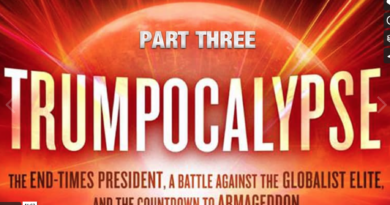The Gospel According to E.T.?
What does the Bible have to say about claims of an advanced, ancient civilization on Earth and the origins of humanity?
By S. Douglas Woodward
Depending upon what we believe about the possibility we aren’t the first highly advanced civilization on this blue globe – the third rock from the sun – we need to consider artifacts from pre-history with more than a little respect.
Admittedly, pop-archeology is trumped up and commercially exploited to ridiculous lengths. Furthermore, and unfortunately, it is wedded to extensive speculation about extraterrestrials.
Additionally, it’s important to acknowledge that the marriage of aliens and the myths of antiquity offer a dangerous and deceptive alternative to conventional Theism. My pejorative epithet for this modern religion is, “The Gospel According to E.T.”
This myth replaces the God of Christians and Jews with creator spacemen named Enlil and Enki, hailing from Planet X (aka Nibiru, as put forth by the late author Zecharia Sitchin). Are Enlil and Enki more believable as ancient gods who made us what we are today?
Despite the widely touted views presented on TV by “ancient astronaut theorists,” the artifacts fall short of proving that E.T.’s exists – and even less, that they merit our worship. These E.T.’s, with few exceptions, seek no disciples.
More to the point, the physical (shall we say terrestrial?) findings of respected scientists who literally get their hands dirty, don’t necessarily seek to replace the God of Heaven with “extraterrestrials from the stars.”
There are numerous incredible discoveries from the recent past which seemingly rewrite what we know about antiquity. Curiously, such discoveries imply startling possibilities which might precede biblical chronology by 3,000 to 5,000 years – even after we replace the conventional chronology based on the Masoretic Text and the work referenced above of Bishop James Ussher – with that derived from the LXX.
As we will see, these surprising findings, assigned by alternate researchers to pre-history, don’t necessarily conflict with primeval biblical chronology. And yet, if we Christians are to acknowledge their efforts, we must have a theory for how they “fit into” our worldview – without refuting the Bible. This book opens the door to this study. Others must go through it.
The Science of Archeology

Nevertheless, it’s significant that a whole lot of digging has been going on since the science of Archeology began. And what’s been dug up has radically changed our knowledge of the past.
Plus, it has significant implications on the religious texts to which we ascribe sacred status. Archeology, i.e., digging up the past, offers empirical evidence to confirm what texts from antiquity tell us. When conflicts often arise, it isn’t that the science is wrong although that is indeed possible. More of the time, the conflict arises because we haven’t understood what the Bible tells us about its historical context.
Consequently, discovering ancient artifacts is a valuable business. And unless we are inclined to dismiss such findings out of hand due to one of the reasons highlighted at the outset of this introduction to Rebooting the Bible, Christian scholarship must reconcile these discoveries with the biblical record.
For this author strongly believes that we must dialogue with our culture. We must earnestly contend for the faith (Jude 3). To be sure, this apologetic emphasis comprises yet another reason behind the writing of this book. For we all are to do the work of an apologist, in our own way, with those we meet and know. “Be prepared to give a reason for the hope that is within you.” (1 Peter 3:15, paraphrased)
Ironically, Archeology’s story starts with Babylon’s last king, Nabonidus (556 BCE to 539 BCE), who commenced a program to repair the ancient temples in Mesopotamia. Nabonidus wished to identify with past Babylonian glories (just as Saddam Hussein did with his Muslim hero from the time of the Crusades, Saladin).
I said ironically, so let me explain. First, Nabonidus’s son was Belshazzar. Yes, that Belshazzar, who toasted his guests with the chalices from Solomon’s Temple destroyed a few decades earlier by his ancestor Nebuchadnezzar.
His crassness so upset the Lord we worship, that Belshazzar and his party guests witnessed some supernatural graffiti, i.e., the “handwriting on the wall.” As if that wasn’t enough entertainment for the evening, the host’s knees knocked loudly. And then (so Daniel recounts) Belshazzar soiled his britches from sheer terror.
The Many Shapes of the Sphinx

But back to the father, Nabonidus of Babylon, humanity’s first archeologist. Nabonidus was co-regent with his son Belshazzar.
For many years, unbelievers criticized the biblical account claiming that Belshazzar (of whom Daniel writes) did not exist in historical records. However, eventually, the situation of the tandem kings was uncovered – thanks to archeologists.
It turned out that the party host was king too. He was one-half of the father-son duo responsible for the downfall of the Neo-Babylonian Empire. How so? Nabonidus was away from Babylon when the Medes and Persians (aka the Achaemenid Empire) snuck under Babylon’s city walls which crossed over the Euphrates.

While the banquet boomed throughout Babylon and the band played on (with whatever instruments were common to Babylonians), the Media-Persian king, Cyrus the Great, conquered Nabonidus’ empire without firing a shot. (Excuse my stylistic anachronism – without shooting an arrow.)
It seems Nabonidus was always away from home. He was searching for some new artifact that could further enhance his commitment to philanthropy for history’s sake. But this time his absence cost him dearly. In this instance, his trekking about as the world’s first archeologist (satiating his search for historical artifacts “between the two rivers” of the Tigris and Euphrates, i.e., the meaning of Mesopotamia), proved ill-advised and horribly timed.
One could point out that, as so many parents learn when they leave home without adult supervision, kids throw wild parties. And Belshazzar holds the record for achieving the most disastrous consequence ever for turning his father’s residence into an unauthorized and tragic bash for his friends.
Consequently, we must put into proper perspective all modern-day searches into antiquity. And here’s how: We begin with what the Bible says. Then we put new discoveries into a biblical context. And we should eagerly do so, for if empirical data merits our paying attention, it could strengthen what we believe about biblical history and open our minds to other convincing reasons to have confidence (while growing wiser, to boot).
In so doing, we build an apologetic that might interest unbelieving scientists and researchers outside the biblical fold, to rethink the Bible’s message and embrace Jesus Christ as Savior. Then, many other skeptics might find faith.
Did an Advanced, Ancient Civilization Exist in 10,000 B.C.?

Gobekli Tepe in Turkey purportedly dates to 10,000 B.C. The pyramids and the Sphinx at Giza, although dated by establishment Egyptologists to the early dynastic period of Egypt – ca. 2850 to 2750 B.C. – offer strong evidence that they were constructed long before The Great Flood of Noah, perhaps dating to the same timeframe as Gobekli Tepe.
Plus, we read at least a half-dozen times a year, that yet another pyramid has been discovered in a faraway place with a strange sounding name, sometimes more substantial than the Giza pyramids. Their purpose still escapes those who study monuments, since they mutter the ludicrous explanation that these are mere Pharaonic tombs.
Just think. All that work for a place to bury a body. Even the Pharaoh’s mummy. And then we learn that “The body is missing.” Say what? No mummy? No sarcophagus? A reasonable person from any age (but apparently not a Ph.D. in ours), would say that providing an innocuous reason such as that for the pyramids is incredulous if not idiotic. There must be a whole lot more to it than a place to bury a dead king. Offering such a weak rationale for doing impossible work way beyond our means today, smacks as a lack of imagination.
The real “Pyramidiots,” so-called, are those scholars who hold to that inane viewpoint. This epithet is hardly deserved by Graham Hancock or Robert Bauval who have been disgraced by orthodox academics employing this moniker, jealous they aren’t selling boatloads of books like Hancock and Bauval.
So, if not a tomb, what function did the builders of the Giza Pyramids intend? In short, the purpose of both monument complexes appears to embody acquired knowledge that has been set in stone, meant to last through any cataclysm, so that survivors down the line wouldn’t have to learn everything all over again, the hard way. In effect, these remarkable edifices were the world’s most elaborate time capsules.

You may recall that Gobekli Tepe after it was built, was buried in a dirt hill (called a tell – also spelled tel – from Aramaic meaning mound), to both hide and protect it for millennia. This strategy seems to have worked perfectly. It had remained hidden for 12,000 years if the age assigned to the site (by orthodox academia) is correct.
The only problem is, once again, scientists haven’t yet figured out precisely what the “knowledge transfer” was that the creators of Gobekli Tepe had in mind when transmitting it to future generations of, presumably, other humanoids.
Perhaps this knowledge was being passed down from one civilization to the next in anticipation that the destruction of the originator’s culture was imminent. This apparent impending cataclysm hitting (no pun intended) at the end of the Pleistocene period is all the rage in alternate history books today. And deservedly so I might add.
However, this semi-benign rationale doesn’t satisfy another alternative historian, Joseph P. Farrell, one of my personal favorites, who argues the Giza site resembles a military array with the oldest and grandest Pyramid of Giza serving as a weapon of mass destruction created by a not so friendly “high civilization” an eon ago. Its purpose: To target objects in space; perhaps celestial bodies like planets!
Absurd? Maybe. Astonishingly, when many more facts are known, it just might supplement the story of the Bible and our universe.
A World of Pyramids

We also know today that scores of megalithic cities lie under hundreds of feet of water just offshore in India, the Mediterranean, in Japan, and in the Caribbean near Cuba.
As I awoke today, another ancient submerged city was purportedly discovered off the coast of Portugal (April 28, 2018). Evidence mounts that the cradle of civilization we call the Fertile Crescent in Mesopotamia may not be the genesis of the first advanced civilization – Zep Tepi (“the first time”), as the ancient Egyptians called it.
Additionally, the artifacts archeologists are finding today suggests a “high civilization” existed then, rather than simple-minded megalithic humans still living in caves. This advanced culture (Atlantis?) may have met its untimely demise ca. 10,000 B.C.
All of these “mega-megaliths” suggest that the beginnings of civilization may not be in Egypt or Mesopotamia after all. Indeed, the cultures which occupy interest in Archeology today, like Egypt and Sumer, could be in some sense, impoverished remnants – meager legacies – to the grandeur that came before.
It is therefore not out of the question (in my view) that an advanced civilization existed on earth before Adam awoke to find Eve by his side. If so, the quest becomes, for workmen so inclined, to integrate this possibility into our biblical worldview. For God is the “first cause” of everything in the universe.
Admittedly, this isn’t an easy task. But the proper approach is not to deny these primeval facts could be true just because we don’t want to upset the tranquility of our revered belief system.
At the same time, I also believe since there is an additional 1,500 years in biblical history that Ussher didn’t grant, many odd things may have happened during the 2,000 years before Noah entered the Ark.
After all, this is the period when the Nephilim walked the earth (Genesis 6:1-4). Many smart, well-informed biblical scholars today believe these giants (aka Rephaim) had a hand or two in the making of these unexplained megalithic structures and in passing technologies down to humanity in defiance of God. The non-canonical Book of Enoch says just that. Fallen angels instructed humanity on forbidden techniques of many kinds – from cosmetics to the weapons of war.
Therefore, we will conclude Rebooting the Bible wrestling with this superbly provocative subject. Admittedly, we don’t know too many facts about this time before time. So, any conclusion we draw amounts to some “high octane speculation” as author Joseph P. Farrell colorfully labels it.
As we walk through the sequence of events and the evidence provided through Archeology and ancient texts (despite what orthodox academics or alternate-history researchers may opine about humanity’s timeline and its ultimate meaning), we who hold the Bible to be God’s infallible Word, must give such theories due consideration, while at the same time bringing wild speculations about E.T.’s back down to earth.

“It is the glory of God to conceal a matter; but the honor of kings to search out a matter.” (Proverbs 25:20, KJV)
In so doing, we hope to reconcile the Bible with bold (but unproven) new theories about ancient civilizations, breathing new life into a combined biblical and natural history.
Thus, the unsuspecting unbeliever may find an unexpected path to faith. We should certainly hope so.
“We shall not cease from exploration, and the end of all our exploring will be to arrive where we started and know the place for the first time.” T.S. Elliot
This article is drawn from the Introduction to Woodward’s new book, Rebooting the Bible.


S. Douglas Woodward, Th.M., MA in Finance (to be completed, May 2019), is 64. He grew up in Oklahoma City, where he lives once again, after working in Boston for six years and Seattle for 21. Doug’s experience lies primarily in business information technology and financial management where he has served as an executive for Oracle, Microsoft, and a Partner at Ernst & Young LLP. He also founded his own consultancy for young companies, Smart Starters, which he managed for 10 years, before becoming Entrepreneur-in-Residence at the University of Oklahoma, Price School of Business, where he has taught classes in entrepreneurship for five years. Over the past seven years, Doug has become a nationally recognized author having written fourteen books on the topics of America’s spiritual history, eschatology, theology, and geopolitics. His books of note include The Final Babylon, Decoding Doomsday, Power Quest (Books One and Two), Lying Wonders of the Red Planet, The Revealing, The Next Great War in the Middle East, and Revising Reality. Rebooting the Bible is number fifteen. He frequently appears on radio and television programs having been interviewed on over 100 different occasions on several dozen different shows. Additionally, he speaks at conferences concerning the multiplicity of topics about which he writes. Doug has two amazing adult children, an incredible daughter-in-law, two fabulous grandsons, and a beautiful wife, Donna, with whom he celebrates over 43 years of marriage. Discover more at www.Facebook.com/sdouglaswoodward and www.faith-happens.com.



